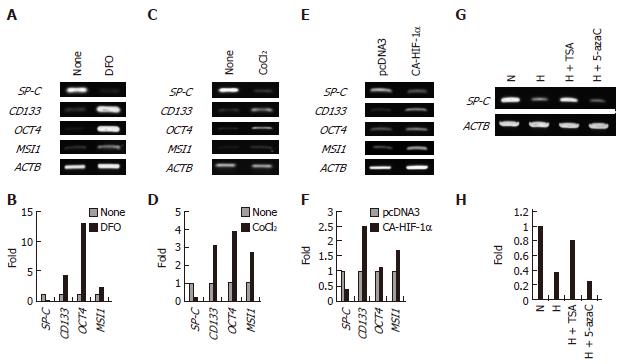Copyright
©2013 Baishideng Publishing Group Co.
World J Med Genet. Nov 27, 2013; 3(4): 41-54
Published online Nov 27, 2013. doi: 10.5496/wjmg.v3.i4.41
Published online Nov 27, 2013. doi: 10.5496/wjmg.v3.i4.41
Figure 7 Hypoxia-inducible factor mediates the expression of differentiation- and stem cell-related genes in A549 cells.
A and B: Effect of DFO, the cells were cultured with or without 100 μmol/L DFO for 3 d; C and D: Effect of CoCl2, the cells were cultured in the presence or absence of 200 μmol/L CoCl2 for 3 d; E and F: Effect of the ectopic expression of HIF-1αP402A/P564A, the cells were transfected with pcDNA3.1 or pcDNA3.1/HIF-1αP402A/P564A and allowed to grow for 2 d; G and H: Effects of TSA and 5-azacytidine on the hypoxia-induced repression of SP-C expression, the cells were cultured under normoxic (N) or hypoxic (H) conditions in the presence or absence of TSA (300 nmol/L) or 5-azacytidine (5-azaC) (4 μmol/L) for 3 d. B, D, F, and H: The expression level of each gene was normalized to that of β-Actin (ACTB), data are shown as fold-change relative to normoxia (normoxia values set to equal 1).
- Citation: Akimoto M, Nagasawa H, Hori H, Uto Y, Honma Y, Takenaga K. An inhibitor of HIF-α subunit expression suppresses hypoxia-induced dedifferentiation of human NSCLC into cancer stem cell-like cells. World J Med Genet 2013; 3(4): 41-54
- URL: https://www.wjgnet.com/2220-3184/full/v3/i4/41.htm
- DOI: https://dx.doi.org/10.5496/wjmg.v3.i4.41









